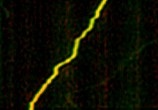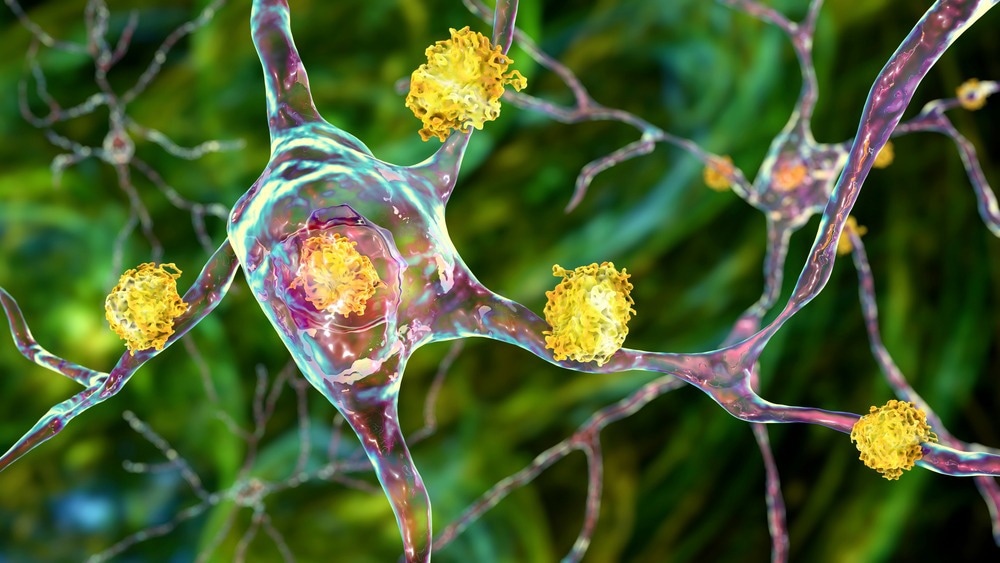Reviewed by Danielle Ellis, B.Sc.Sep 28 2022
A recent study led by the University at Buffalo proposes a novel role for the huntingtin protein (HTT), which leads to Huntington’s disease when mutated.
 The jagged line shows the path of HTT and Rab7 proteins moving along a neuronal highway called an axon in an injured neuron. HTT and Rab7 have each been tagged with different color markers in this microscope imagery, and they appear to be traveling together in a single compartment, with their shared path appearing in yellow. Experiments suggest that this HTT package may carry signaling molecules that “are essential for activating the production of proteins needed for neuron regeneration,” says University at Buffalo biologist Shermali Gunawardena. Image Credit: TJ Krzystek.
The jagged line shows the path of HTT and Rab7 proteins moving along a neuronal highway called an axon in an injured neuron. HTT and Rab7 have each been tagged with different color markers in this microscope imagery, and they appear to be traveling together in a single compartment, with their shared path appearing in yellow. Experiments suggest that this HTT package may carry signaling molecules that “are essential for activating the production of proteins needed for neuron regeneration,” says University at Buffalo biologist Shermali Gunawardena. Image Credit: TJ Krzystek.
A group led by UB biologist Shermali Gunawardena has been studying HTT and its basic roles in neurons for a long time. HTT, in its unmutated form, was long known to travel along neuronal highways termed axons, both toward and away from the cell's nucleus.
In a new study, a previously unrecognized function of HTT in cellular compartments that move in one direction, toward the nucleus, is described, adding to the existing body of knowledge from earlier studies. The results suggest that HTT is involved in neuronal injury and regeneration, according to Gunawardena, PhD, associate professor of biological sciences in the UB College of Arts and Sciences.
We are finding that HTT is packaged in different types of moving cargo within cells, and that it’s involved in so many processes. This suggests that it’s really a key protein in controlling a lot of cellular pathways that are important in cell survival. It doesn’t have just a single role, so it’s a very complex protein to understand.”
Shermali Gunawardena, Associate Professor, Biological Sciences, College of Arts and Sciences, University at Buffalo
According to Gunawardena, in the new paper, “We show that the huntingtin protein is involved during neuronal injury. When neurons in fruit fly larvae were injured, we see that HTT moves from the injury site to the cell body. It likely carries components that are necessary for survival of the neuron toward the cell body, where the nucleus is and where proteins are made.”

Image Credit: Kateryna Kon/Shutterstock.com
The experiments carried out revealed that this HTT package might carry signaling molecules that “are essential for activating the production of proteins needed for neuron regeneration.” Gunawardena says that “future studies will be needed to determine the identity of the molecules involved in the regeneration.”
The research was published on September 9th, 2022, in the Autophagy journal.
While many studies investigate disease mechanisms of HTT in Huntington’s disease, here we focused on investigating basic roles of HTT in neurons. By combining a variety of laboratory techniques, we were able to model a novel mechanism in which HTT helps injury signals transport back to the cell body after axonal injury.”
Thomas J. Krzystek PhD, Study First Author, Department of Biological Sciences, University at Buffalo
Krzystek carried out the research as a PhD student in biological sciences at UB. Krzystek is currently a postdoctoral research fellow at Boston Children’s Hospital, Harvard Medical School, and the National Institutes of Health.
Krzystek concludes, “We have known for decades that neurons of the central nervous system exhibit poor regeneration following axonal injury. By investigating more unconventional proteins and pathways in the context of axonal regeneration, we can learn more about the potential causes of this problem with the goal of eventually opening up possibilities for finding and validating future candidates to target new therapies.”
HTT and Rab7 proteins in an injured neuron
In an injured neuron, HTT and Rab7 proteins move along a neuronal highway called an axon, traveling toward the cell body. HTT and Rab7 have each been tagged with different color markers, and they appear to be traveling together in a single compartment that is seen in yellow in this video. Experiments suggest that this HTT package may carry signaling molecules that “are essential for activating the production of proteins needed for neuron regeneration,” says University at Buffalo Shermali Gunawardena, senior author of a new study that reports on these findings. Video Credit: TJ Krzystek.
Source:
Journal reference:
Krzystek, T. J., et al. (2022) HTT (huntingtin) and RAB7 co-migrate retrogradely on a signaling LAMP1-containing late endosome during axonal injury. Autophagy. doi.org/10.1080/15548627.2022.2119351.